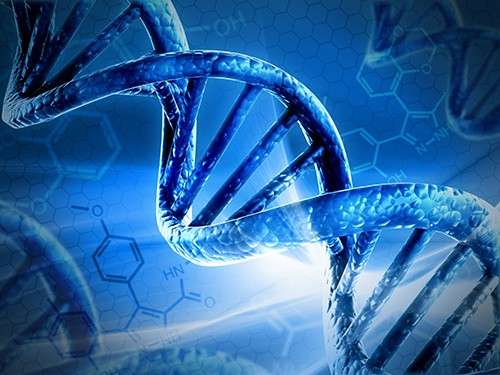Messing with the genetic recipe: Fresh clues to why we're short, average or tall

How tall we are is not simply governed by the genes written in our DNA – it's also got to do with how that DNA is folded inside our cells.
New research by New Zealand scientists has, for the first time, pinpointed how sections of DNA, known as SNPs, influence genes that determine height.
"The techniques we used in this study will help us better identify and treat those at risk of growth disorders," says study lead, Dr Justin O'Sullivan, a geneticist at the Liggins Institute, at the University of Auckland.
"What's especially exciting, is that they also offer a way to unlock the riddles of many diseases and disorders that we know can be passed on from parent to child, but that don't seem to pass directly through the genes," he says.
In the study, Liggins Institute PhD student William Schierding screened 700 SNPs, and found evidence that ten percent – 68 – made contact with genes known to be involved in height.
SNPs, pronounced "snips", stands for single nucleotide polymorphisms. They're points in the DNA that commonly vary between individuals and that have been linked to a disease.
"Height carries status in Western societies," says Professor Wayne Cutfield from the Liggins Institute, who was part of the research team.
"Taller people are more likely to be picked in sports teams, be more popular, get more jobs, to earn more. On the other hand, extremely short children are very socially disadvantaged. Currently, they're treated with growth hormones, but this doesn't work for everyone."
The SNPs finding lends weight to a new way of thinking about DNA and the human genome that is gaining traction among geneticists.
"There was this idea that mapping the human genome would reveal everything about human development and disease," says Dr O'Sullivan. "The full human genetic sequence was published 13 years ago, but many mysteries remain. It's now becoming clear that we also need to understand the other forms of information in DNA that affect how genes are read and used."
The human genome is the complete set of DNA that contains the genetic blueprint for building a human. DNA are the long molecules inside our cells that encode the recipes for not only for the type of cell they're in, but for all cells in the human body. Genes are segments of DNA that contain the recipe or code for particular proteins, which, in turn, help create a particular biological trait. Yet, most of our DNA isn't genes.
"A large part of our DNA is thought to have no function, to exist essentially as spacers between genes," explains Professor Cutfield. "Our study adds to the growing evidence that shows that this so-called inactive DNA, though the way it's folded, can influence genes indirectly."
Unwound, the DNA that makes up the human genome is about 2 metres long. This DNA is squeezed into a cell nucleus – essentially a bag inside a cell – which is only ten nanometres across (100,00th of a millimetre). To fit, the DNA is tightly coiled around disc-like proteins, like thread around bobbins. Through this coiling, segments that are far apart when the DNA is stretched out, come into contact with each other.
This is where SNPs come in. Sometimes SNPs occur inside genes, but most – about four in five - fall outside genes. It's easy to understand why diseases linked to SNPs inside genes, such as cystic fibrosis, can be passed down between generations – they're passed down through the genes.
The heritability of diseases linked to SNPs outside genes was puzzling until scientists started wondering whether the way that DNA folding brought SNPs into contact with far-off genes mattered.
"The theory is that SNPs outside the genes are changing the activity of the genes they make contact with, causing them to overproduce or under-produce certain proteins, and this is what causes the disease – or, in the case of height, extreme short stature," says Dr O'Sullivan.
Experiments by team members Jisha Antony and Julia Horsfield clearly demonstrated that some of these SNP gene interactions change the way genes are read.
"The SNPs are messing with the cell's genetic recipe," says Dr O'Sullivan.
The researchers are now applying this technique to try to gain some new understanding of rheumatoid arthritis, obesity, diabetes and gout. It is possible that medicines could be developed that neutralise the distorting effects of SNPs, restoring biochemical balance, Dr O'Sullivan says.
"This really opens new doors for us. We believe this approach ultimately will lead to new gene-based treatments for many conditions."
The research was conducted by researchers at the Liggins Institute, University of Auckland and at the Department of Pathology, Dunedin School of Medicine, University of Otago.
The study was published in the journal Human Molecular Genetics.
More information: Intergenic GWAS SNPs are Key Components of the Spatial and Regulatory Network for Human Growth. Hum Mol Genet. 2016 Jun 10. pii: ddw165. hmg.oxfordjournals.org/content … jkey=Pg5keGNWghtnlBG


















